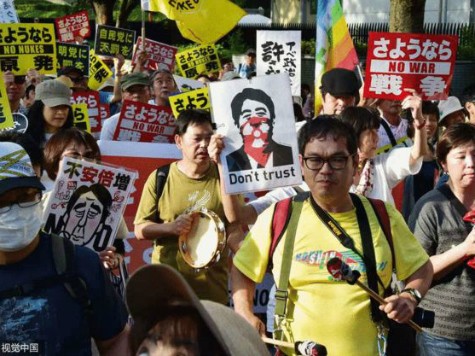A report in Bloomberg cites a Japanese intelligence agency report suggesting that China is working to embolden separatist groups in Okinawa, just as China has increased its public demands for the world to disregard Taiwan’s sovereignty and observe Beijing’s “One China” policy.
In a report, Bloomberg states that Japan’s Public Security Intelligence Agency has warned that Chinese “universities and think tanks” – all connected with the Communist Party running the country from Beijing – have been attempting to network with activists on Okinawa, seeking to “deepen ties.” It is unclear from the text of the report what specific measures China has taken to deepen these ties, though the agency warns that Japanese government officials should be mindful of these ties.
Okinawa boasts an existing, if not particularly robust, separatist movement, as well as political activists who are not advocating for Okinawa to split from Toyko but do want to see the U.S. military presence on the island diminished. In one of the larger displays of the latter, an estimated 50,000 Japanese gathered in June to protest the U.S. presence on Okinawa following the rape and murder of 20-year-old Rina Shimabukuro. American military contractor Kenneth Shinzato was arrested and charged with the crime.
While Beijing has not openly supported Okinawa independence movements, it has claimed the island and the Ryukyu island chain as its own. In 2013, the Chinese People’s Daily propaganda newspaper published a report quoting numerous Chinese military officials and academics challenging Japan’s claim to the islands. “They were certainly China’s tributary state,” Chinese General Luo Yuan was quoted as stating. “We can say with certainty that the Ryukyus do not belong to Japan.” The report went on to cite Chinese government historians who claimed Japan’s annexation of the islands in 1879 was an invalid “invasion.”
Okinawa is not considered part of an active territorial dispute between the two nations, however, the way the Senkaku Islands of the East China Sea are. China considers the Senkakus (the “Diaoyu” in China) sovereign territory and has placed a largely disregarded Air Defense Identification Zone (ADIZ) over the region.
It has also not posed the same political problems to Japan that China’s separatist regions have to Beijing. China is currently combatting independence movements in four regions: Taiwan, considered by more than a dozen nations a sovereign state; Hong Kong; Tibet; and western Xinjiang province.
Taiwan, under pro-independence President Tsai Ing-wen, has become a growing matter of alarm in Beijing, particularly after President-elect Donald Trump accepted a congratulatory phone call from Tsai and later publicly challenged the “One China” policy. “One China” is Beijing’s term for the policy of disregarding the anti-communist governments of sovereign states and breakaway regions that reject its authority. As Foreign Ministry spokeswoman Hua Chunying has repeatedly explained it, “There is only one China in the world, the government of the People’s Republic of China is the only legitimate government representing China, and Taiwan is an integrated part of the Chinese territory.”
Tsai will briefly visit the United States in January.
While unable to enforce the ADIZ over the East China Sea– as striking a Japanese aircraft that did not identify itself to China would force the United States to retaliate, as per World War II treaties – China has, nonetheless, continued to exert its military influence in Asia’s waters generally, most prominently in the South China Sea. This week, China sent its lone aircraft carrier, the Liaoning, into the South China Sea for military exercises, sailing near Okinawa for the first time.
Partly in response to growing Chinese military encroachments in the South and East China Sea, Japan recently approved its largest defense budget in modern history, allocating $43.5 billion to its Self-Defense Forces that will go to, among other equipment, new F-35A Lightning II Joint Strike Fighters, Bell Boeing V-22 Osprey tilt-rotor aircraft, and an attack submarine.

COMMENTS
Please let us know if you're having issues with commenting.